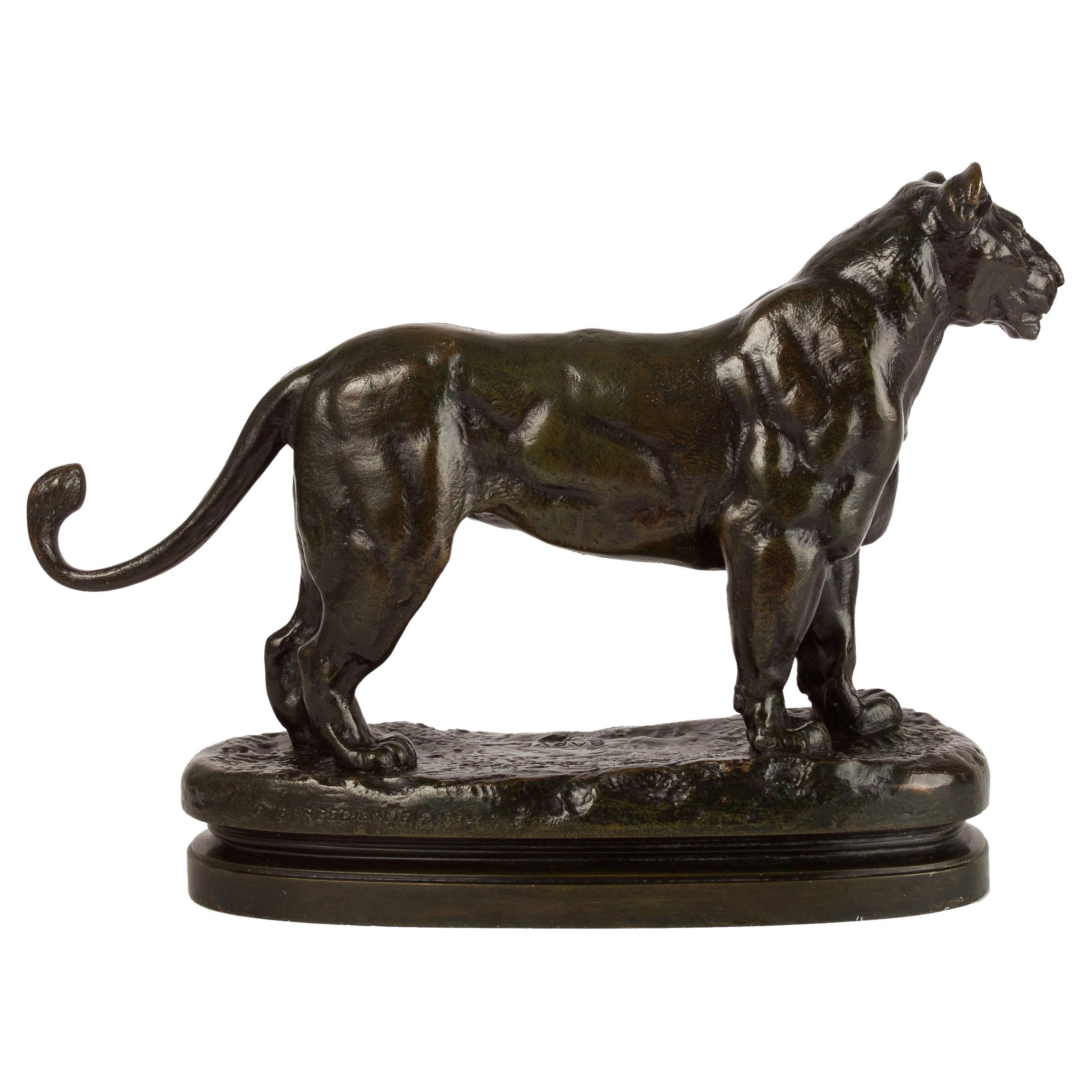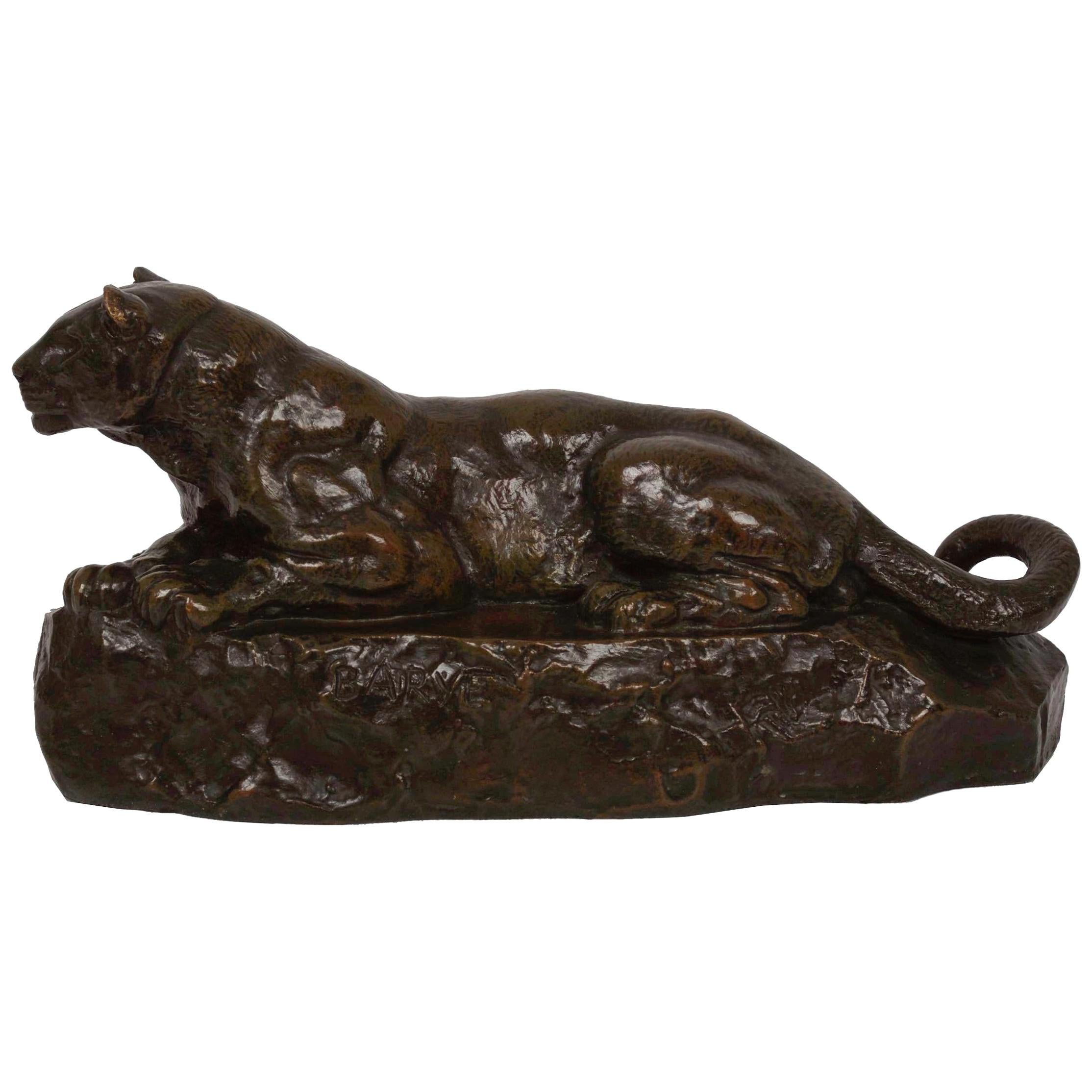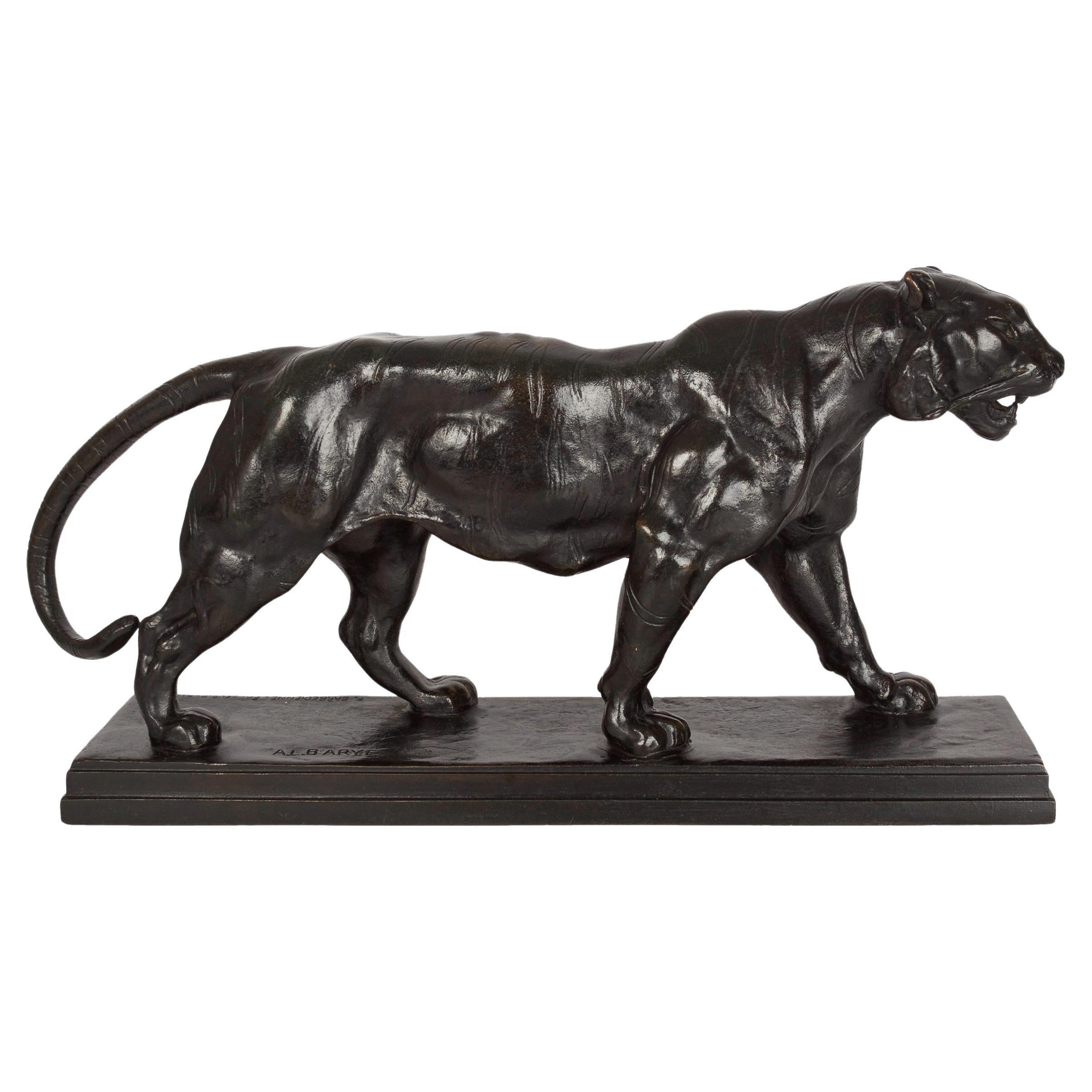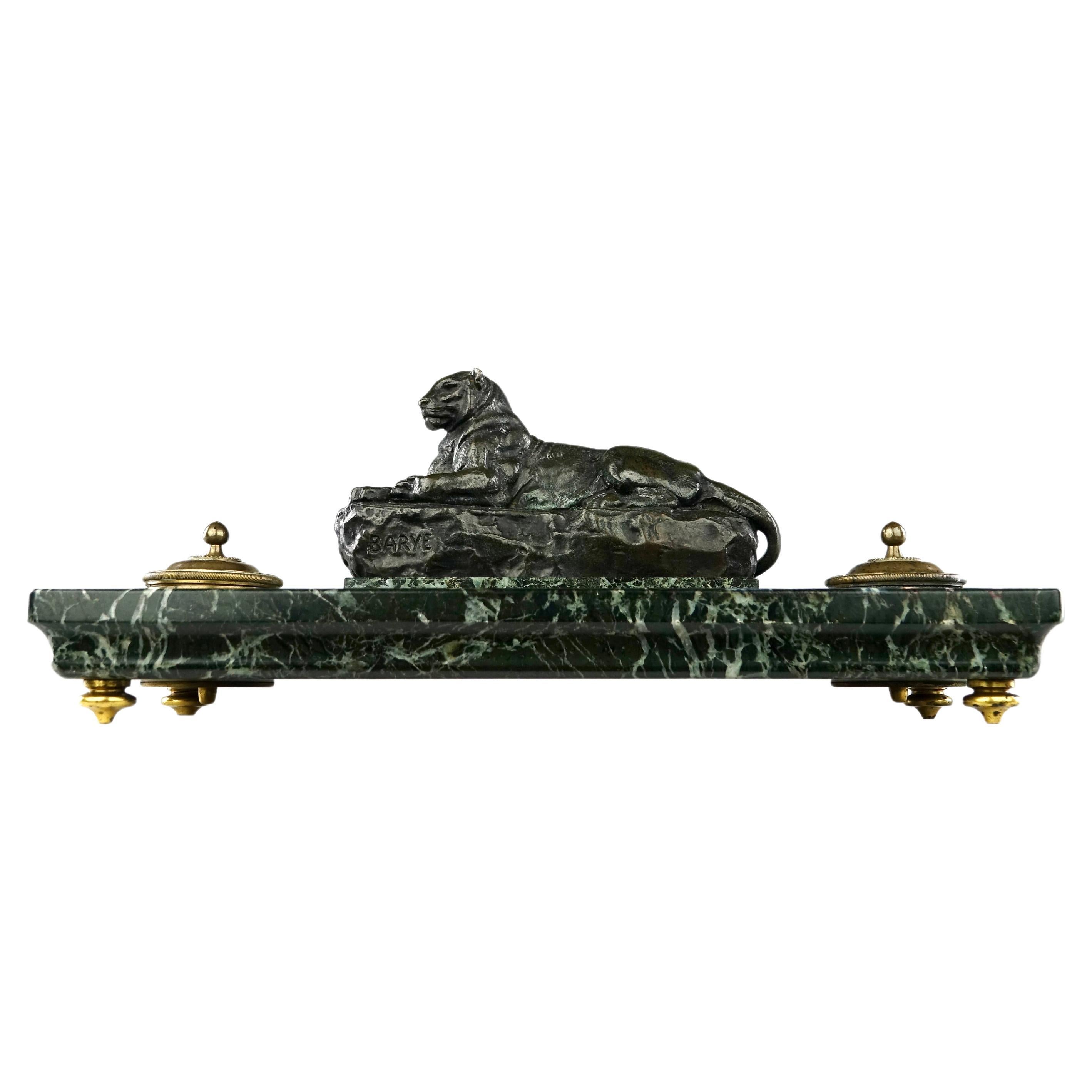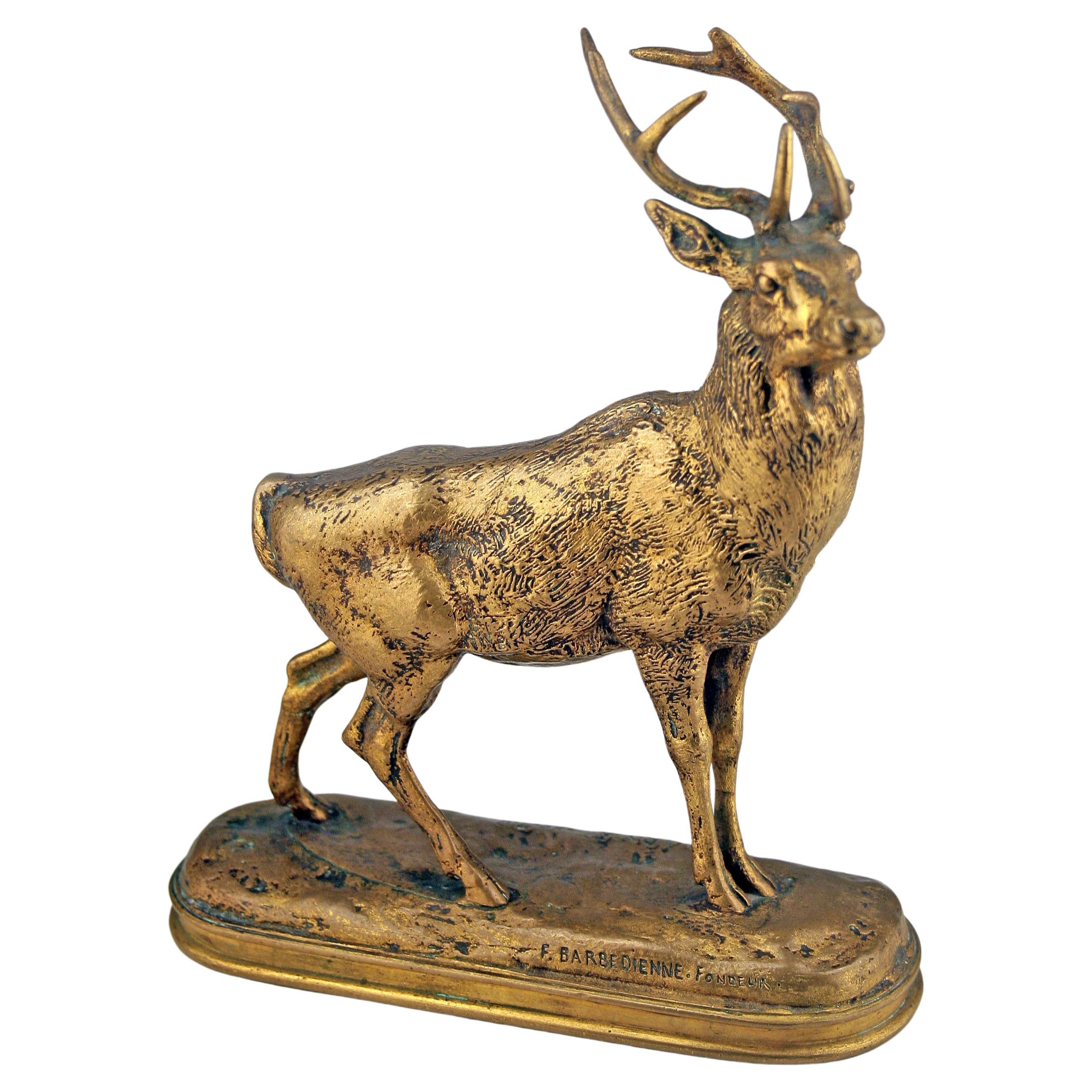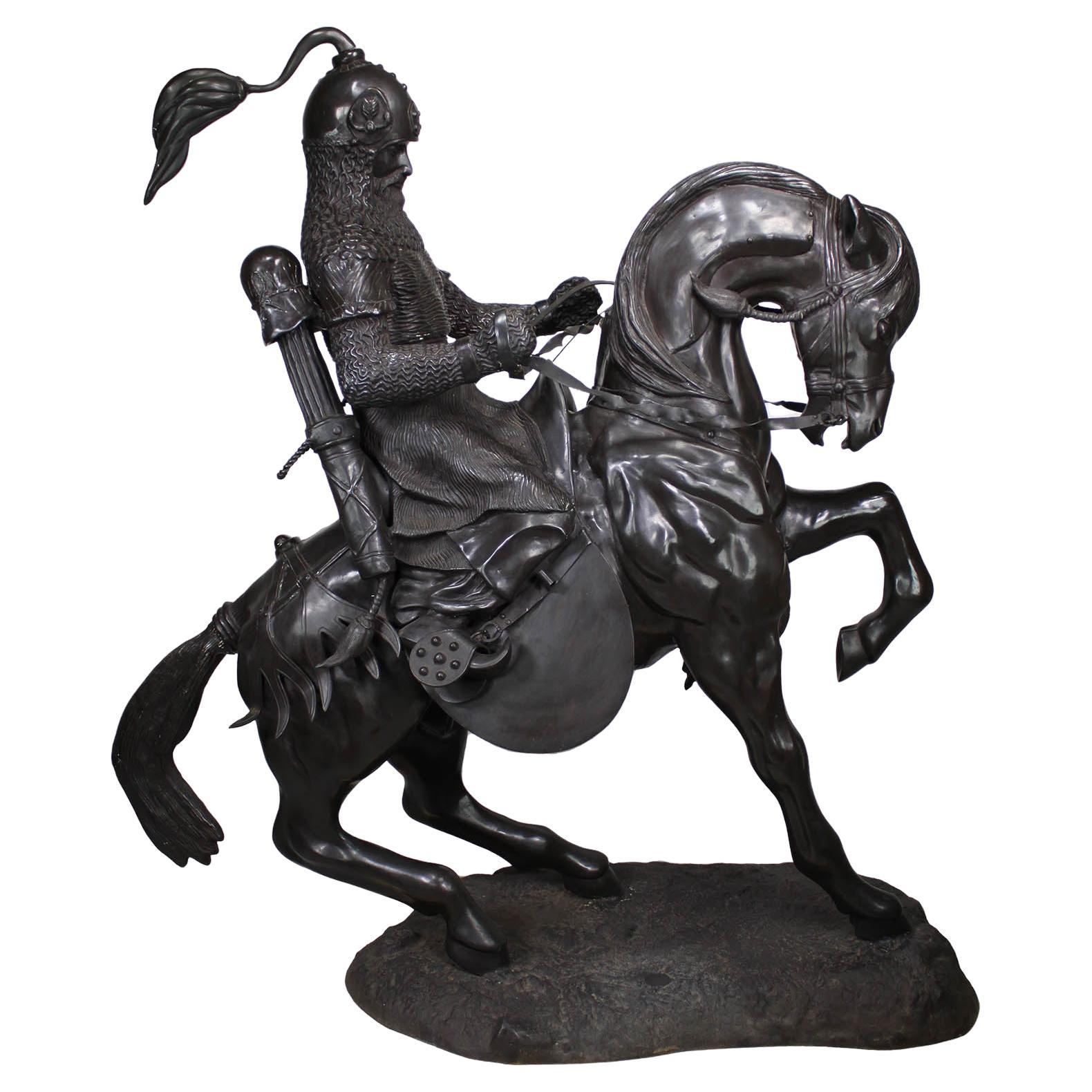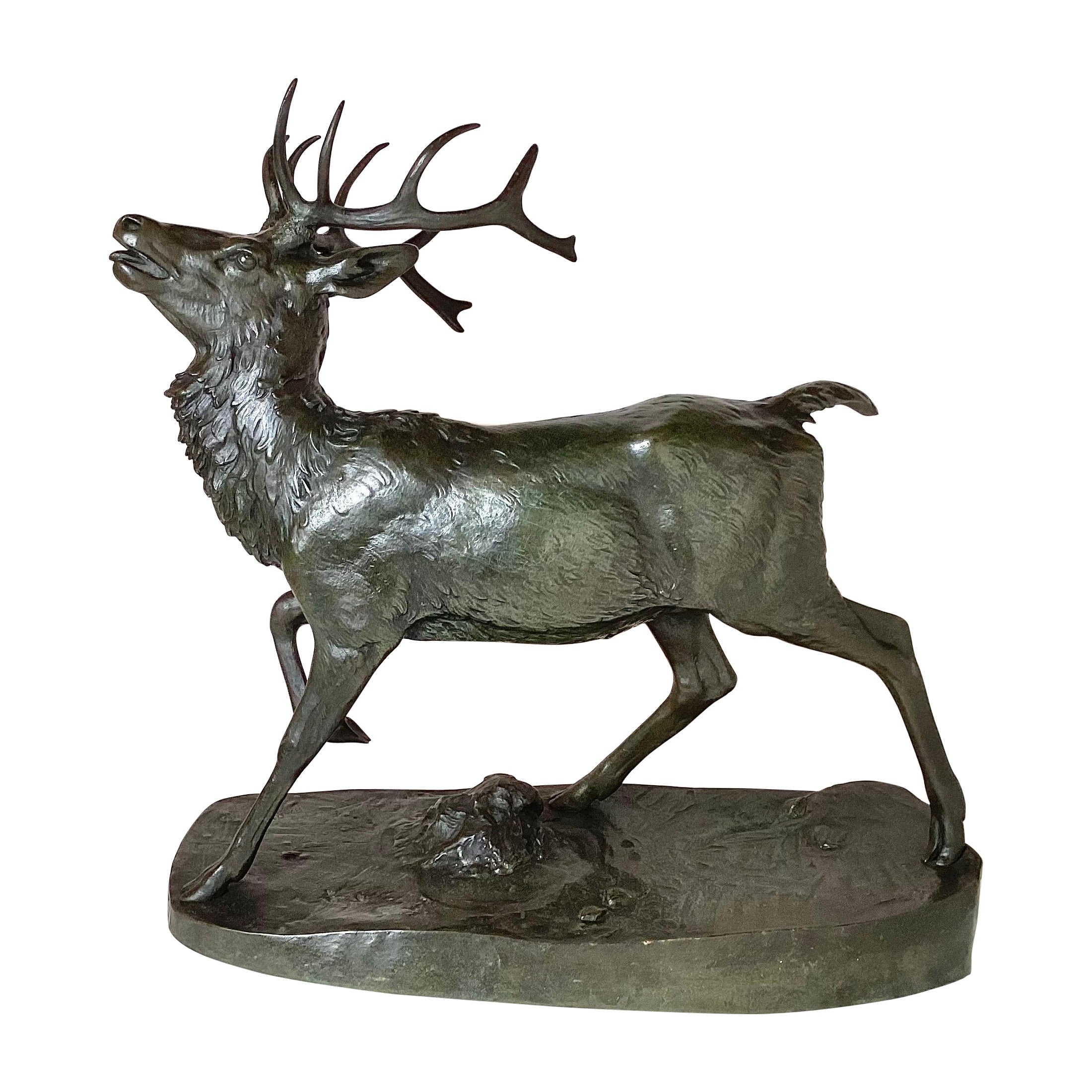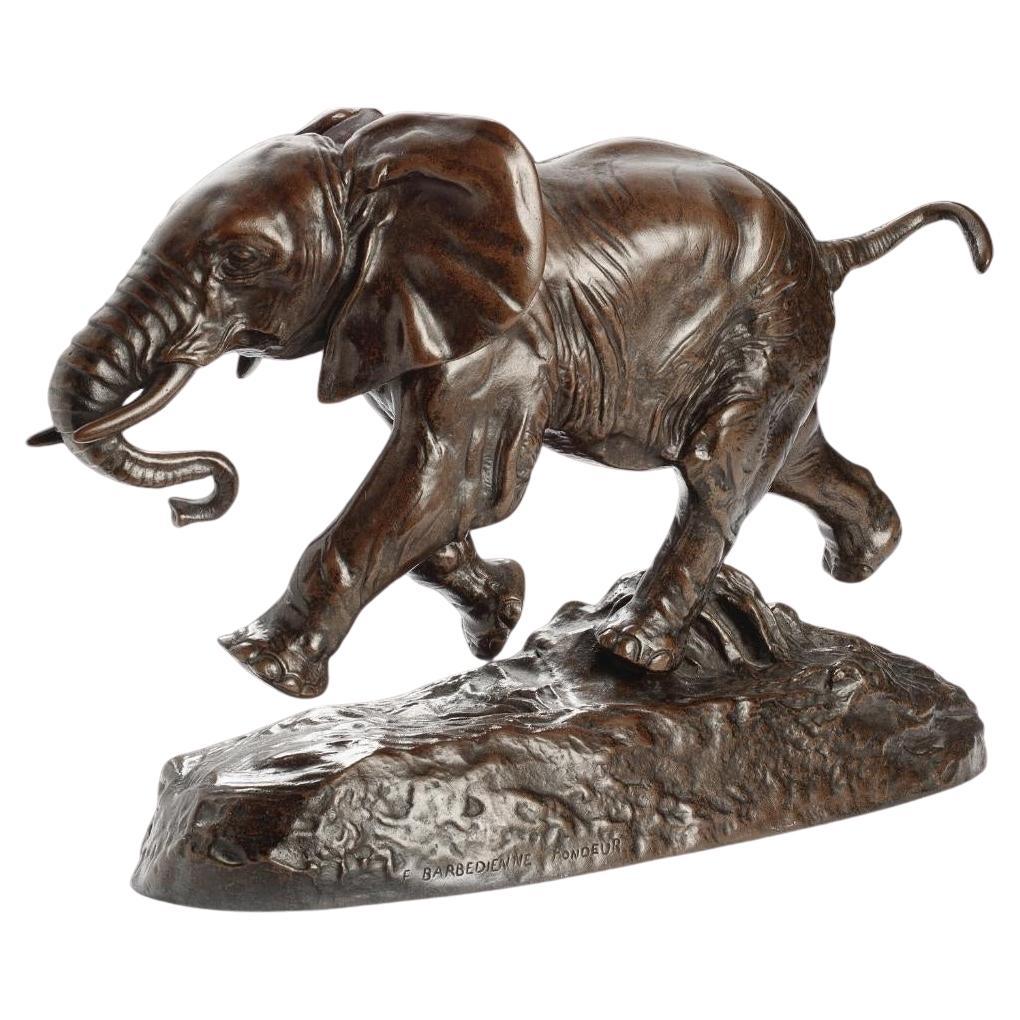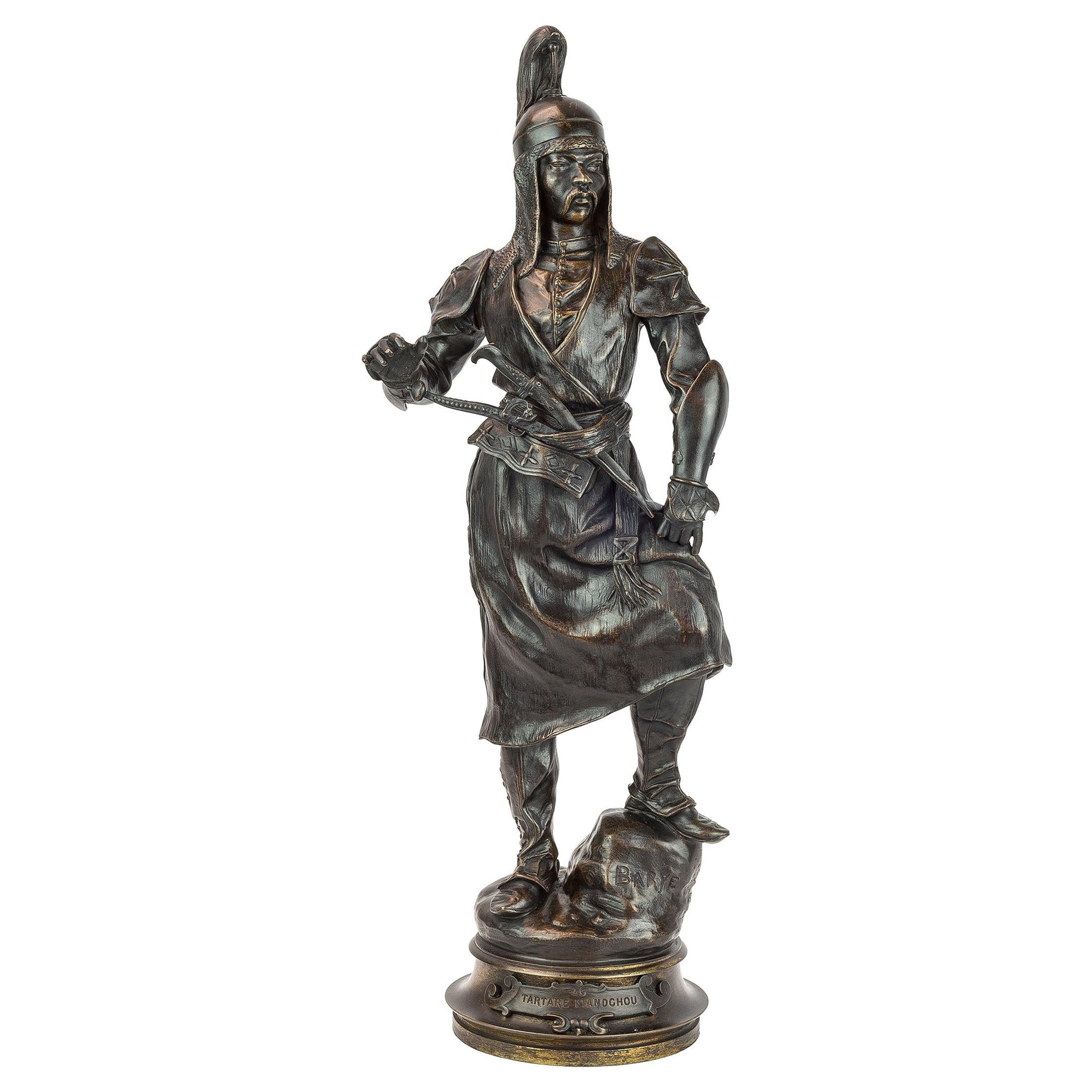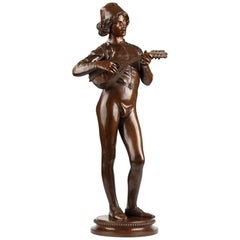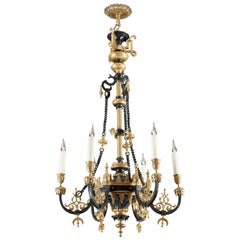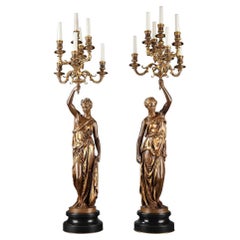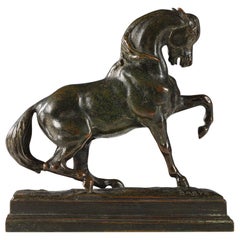
Beautiful "Turkish Horse n°3" Bronze Sculpture by Barye & Barbedienne
View Similar Items
Beautiful "Turkish Horse n°3" Bronze Sculpture by Barye & Barbedienne
About the Item
- Creator:Antoine-Louis Barye (Artist),Ferdinand Barbedienne (Maker)
- Dimensions:Height: 4.93 in (12.5 cm)Width: 4.93 in (12.5 cm)Depth: 2.17 in (5.5 cm)
- Materials and Techniques:
- Place of Origin:
- Period:
- Date of Manufacture:Circa 1880
- Condition:
- Seller Location:PARIS, FR
- Reference Number:Seller: 1461/01stDibs: LU3860311409451
Ferdinand Barbedienne
Founded by one-time Parisian wallpaper dealer Ferdinand Barbedienne and engineer Achille Collas, one of the most revered foundries in 19th-century France began with the invention of a revolutionary 1830s-era device that could produce proportional reproductions — large or small — of sculptures. Collas’s machine, which yielded miniature likenesses of antiquities for the interiors of homes the world over, was pivotal to the success of the F. Barbedienne Foundry. The successful firm earned prestigious awards and critical acclaim and created exquisite bronze candleholders, clocks and lamps for a range of wealthy and prominent clients.
The duo first launched their company under the name Société Collas et Barbedienne, and early on, they optimized chemical processes for pigmenting and patinating their bronze statuettes. After Collas died in 1859, Barbedienne forged on alone, and the company’s name changed to simply F. Barbedienne.
Barbedienne employed more than 300 workers at that point, and the Maison created a range of furnishings and decorative objects that featured the integration of marble and ormolu accents. However, with the onset of the Franco-Prussian War of 1870, the foundry was forced to retrofit its molds, and the production of cannons replaced sculptures, furniture and vases.
When Ferdinand Barbedienne passed away in 1891, his nephew and heir, Gustave Leblanc, took over as president, changing the name to Leblanc-Barbedienne. Leblanc expanded production into Germany, the United Kingdom and the United States, carrying on the company's legacy with monumental sculptures, and models and securing production rights for famous statues. Paul-Alexandre Dumas, an Art Nouveau maker and student of Louis Majorelle, succeeded Leblanc until the company's closing in 1952.
Barbedienne pieces had been exhibited regularly in the 19th century and were especially prevalent at Europe’s international expositions and world’s fairs, where they received numerous prizes. Today, the Musée d’Orsay in Paris holds dozens of Barbedienne works in its collection, including intricate mirrors, vases and cups created by Louis-Constant Sévin at the foundry. For more than two decades, Sévin created lamps, boxes and more at Maison Barbedienne. Working alongside award-winning chaser Désiré Attarge, Sévin designed Napoleon III-era works that greatly appealed to European nobility.
Other notable artists who collaborated with Barbedienne included Eugene Aizelin, Emmanuel Fremiet, Antonin Mercié, Emile Guillemin, Edouard Lievre, Ferdinand Levillain and Auguste Rodin.
On 1stDibs, find a collection of antique Ferdinand Barbedienne decorative objects, lighting and more.
Antoine-Louis Barye
The son of a goldsmith, Parisian born Antoine-Louis Barye was a sculptor of animal subjects and acclaimed, not only for his apparent skill but as the founder of what became known as the French Animaliers School. Among his patrons were representatives of the state government and royalty, including the Duke of Orleans and the Dukes of Luynes, Montpensier and Nemours.
Well compensated financially, Barye was able to buy the best of materials and hire the country's most skilled foundry craftsmen. The foundry he hired was owned by Ferdinand Barbedienne and casts from this period were stamped with the letters, FB. However, he did not make a lot of money from his work because he was such a perfectionist that often he would not sell his work because he thought it was not "quite right." In 1848, he declared bankruptcy and his molds and plaster casts were sold along with the copyrights.
Barye's specialty was aroused, angry-seeming wild game such as lions and tigers and elephants, but he also did equestrian groups and mythology figures. In order to do realistic depictions of animal anatomy, he spent much time at the Jardin des Plantes in Paris. His early training was as an apprentice to a metal engraver, but being drafted in the army in 1812 ended that education. In 1832, he had established his studio, and unique at that time was his method of cold stamping his bronze casts so that each one had a special number. He had his first entry, The Milo of Croton, in the Paris Salon in 1819, winning a second prize. In 1831, a work regarded as a masterpiece, Tiger Devouring a Gavial, was in the Salon and purchased for the Luxembourg Gardens, which is now in the Louvre. However, many of his subsequent Salon submissions were rejected and so angered him that between 1836 and 1851, he refused to submit entries. In 1851, he again exhibited at the Salon with Jaguar Devouring A Hare, and this work, like the 1831 entry, was placed in the Luxembourg Gardens and eventually in the Louvre.
In spite of problems with the Salon, Barye received many accolades for his work, and the period of 1837–48 was considered the most productive time of his career. However, in 1848, when he lost control of his work and it was reproduced by others including Martin and Barbedienne, the sculptures, according to some art professionals, are not as skillfully executed. In 1848, after his bankruptcy, Barye became director of Casts and Models in the Louvre, until 1850, when he was replaced by Emmanuel Fremiet. It was a very difficult time for him. However, within a few years, he began receiving accolades for the quality and uniqueness of his work, and people began appreciating the powerful images of his sculpture, especially the wildlife in their natural surroundings. In 1854, he was appointed Master of Zoological Drawing in the Musée National d'Histoire Naturelle and held this position until his death in 1875.
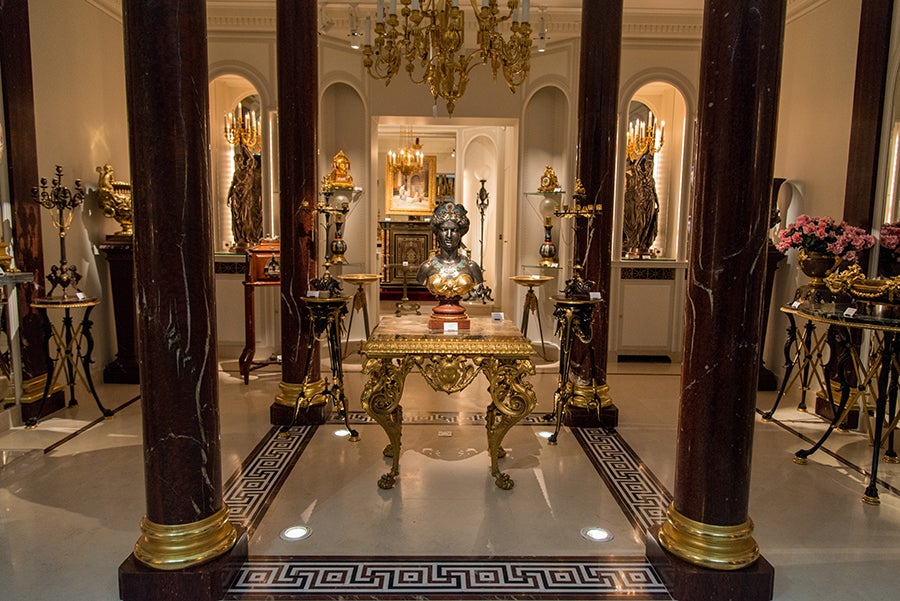
- "Florentine Singer" Bronze Sculpture by P. Dubois and F. Barbedienne, Circa 1880By Paul Dubois, Ferdinand BarbedienneLocated in PARIS, FRSigned P. Dubois 1865 and F. Barbedienne fondeur Stamped with réduction mécanique Collas A patinated bronze « Florentine Singer » sculpture, inspir...Category
Antique 1880s French Figurative Sculptures
MaterialsBronze
- Beautiful Ottoman Style Chandelier Attributed to F. Barbedienne, France, c. 1870By Ferdinand BarbedienneLocated in PARIS, FRBeautiful oriental style six-light arms chandelier attributed to F. Barbedienne, made in patinated and gilded bronze. With a very Fine decoration of arabesques, cords and valances im...Category
Antique 1870s French Chandeliers and Pendants
MaterialsBronze
- Elegant Pair of Bronze Torcheres by F. Barbedienne, P. Dubois and A. FalguièreBy Paul Dubois, Jean Alexandre Joseph Falguière 1, Ferdinand BarbedienneLocated in PARIS, FRMODEL PRESENTED AT THE 1867 PARIS UNIVERSAL EXHIBITION Listed in the Ferdinand Barbedienne’s catalogue as the “Deux femmes debout” (Two standing ladies) Signed on each one P. Dubois – F. Barbedienne Fondeur and A. Falguière – F. Barbedienne Fondeur Rare pair of parcel-gilt and patinated bronze figures, representing two women dressed in Antique style costume with jewels, each upholding a seven lights-arm candelabra. Standing on round bronze bases and black marble socles. Paul Dubois (1827-1905) entered the Paris Beaux-Arts School in 1858. He exhibited at the 1865 Salon the Chanteur Florentin, illustrating Florentine sculpture, observed after his journey in Italy. This work, cast that time in silvered bronze, was exhibited at the 1867 Paris Universal Exhibition (now preserved at the Orsay museum). Dubois' success brought him many commissions, both private (Portrait of Duc d'Aumale) and public (Jeanne d'Arc, in Reims). Appointed curator at the Luxembourg museum in 1873, Dubois became also a member of the Institute and finally headmaster at the Beaux-Arts School in 1878. Alexandre Falguière (1831-1900) studied under Jouffroy at the Paris Ecole des Beaux-Arts, began his career at the Paris Salon in 1857 and won as soon as 1859 the “Prix de Rome”. Falguière became very quickly successful and was several times awarded medals at the Salon, such in 1868 with his marble sculpture Tarcisius the Christian Boy-Martyr, or at the 1867 Paris Universal Exhibition, where he won the first medal in his category. Thanks to that success, he was immediately commissioned by private collectors as well as by the French State, whom asked him in 1878 to realize the Triomphe de la République, placed in 1881 at the summit of the Paris Arch of Triumph...Category
Antique 1860s French More Lighting
MaterialsBronze
- Pair of Neo-Greek Bronze Floor Lamps by F. Barbedienne, France, circa 1860By Ferdinand BarbedienneLocated in PARIS, FRHeight without/with lampshade : 168/185 cm (66,1 / 72,8 in.) ; Base : 43 x 43 cm (16,9 x 16,9 in.) Beautiful pair of neo-Greek floor lamps in bronze with double patina, composed of cylindrical lamps, decorated on the body with a rotating frieze representing women dressed in the Antique style weaving and spinning, surmounted by lampshades with cut sides in red pleated silk with golden braid. They are placed on pedestals from which hang thin chains attached to the slender shaft decorated with stylized leaves and flowers, resting on a tripod base decorated with large palmettes and ending in lion’s paws. The stylistic repertoire used here, composed in particular of palmettes, masks, and nymphs, evokes Greek Antiquity, as does the reuse of forms of furniture and objects such as tripods and antique vases. The rediscovery in the 18th century of the archaeological remains of Pompeii and Herculaneum allowed artists of all disciplines to draw inspiration from Antiquity while reinterpreting it. This trend did not fade and, in the 19th century, many personalities fitted out their interiors with neo-Greek furniture, as was the case for the Maison Pompéienne built in 1856 by the architect Alfred Normand (1822-1909) for Prince Napoleon, or Empress Eugénie who bought from the Maison Barbedienne pedestals inspired by antique tripods. Related work : Pedestal model presented by Maison Barbedienne at the Universal Exhibition in Paris in 1855. On this occasion, Empress Eugénie bought it for her bathroom in the Château de Saint-Cloud. This model pleased the Empress so much that she ordered two other pairs in 1858 for her boudoir in the palaces of Compiègne and Fontainebleau. (see photo attached) Photo showing a floor lamp similar to ours in Empress Eugénie’s bedroom in the Château de Compiègne (Oise), in Architecture intérieure et Décoration en France des...Category
Antique 1860s French Greek Revival Floor Lamps
MaterialsBronze
- Charming enamel and gilded Bronze Ewer by F. Barbedienne, France, circa 1870By Ferdinand BarbedienneLocated in PARIS, FRSigned F. Barbedienne & Cie Height : 31,5 cm (12,4 in.) ; Width : 12 cm (4,7 in.) ; Depth : 10,5 cm (4,1 in.) Charming baluster-shaped ewer in gilded bronze decorated with red and blue polychrome cloisonné enamel. Two beaded handles connect the body to the slender neck, ending in a flared pouring spout, and it rests on a circular piedouche. The whole is decorated with abundant engraved decoration of foliage interlacing. Barbedienne and the Cloisonné enamel : Ferdinand Barbedienne continuously innovated and he revived the use of enamel on art works during the second half of the 19th century. The Sèvres Manufacture enamel workshop had ever tried it in 1854-1855, but Barbedienne was the one who succeeded to join enamel to an industrial decorative objects production. From 1858 “At Mr Barbedienne’s, enamels in copper ornaments have got their former prestige back” (Les bronzes de la Maison Barbedienne, C. Simon, in L’Art du XIXe siècle, 1858, n°21, p. 252). The Barbedienne Company had now an enamel workshop where objects ornamented with oriental style or medieval style enamels were made. Four years after, Barbedienne’s cloisonné...Category
Antique 1880s French Napoleon III Vases
MaterialsBronze, Enamel
- Harlequin by R. de Saint Marceaux, Cast by F. Barbedienne, France, Circa 1880By René de Saint-Marceaux, F. Barbedienne FoundryLocated in PARIS, FRSignature of René Saint-Marceaux and dated 1879 Signed F. Barbedienne Fondeur Paris A. Collas Mechanical Reduction Stamps Reduced Size: 3/5 Elegant statue of a standing Harlequin, ...Category
Antique 1880s French Figurative Sculptures
MaterialsBronze
- Bronze Sculpture "Lioness of Senegal" by Antoine-Louis Barye & BarbedienneBy F. Barbedienne Foundry, Antoine-Louis BaryeLocated in Shippensburg, PAANTOINE-LOUIS BARYE French, 1795-1875 "Lionne du Sénégal" Patinated bronze signed in base "BARYE" incised "F. Barbedienne, Fondeur, Paris" conceived 1857, sand-cast circa 1900 ...Category
20th Century French Romantic Animal Sculptures
MaterialsBronze
- Bronze Sculpture "Panther of Tunisia" After Antoine-Louis Barye, BarbedienneBy F. Barbedienne Foundry, Antoine-Louis BaryeLocated in Shippensburg, PA"PANTHÈRE DE TUNIS NO. 2" AFTER A MODEL BY ANTOINE-LOUIS BARYE (FRENCH, 1796-1875) Signed in base "BARYE", incised to edge "F. Barbedienne Fondeur"; underside incised "24 / Z"; cast ...Category
Antique 19th Century French Romantic Animal Sculptures
MaterialsBronze
- French Bronze Sculpture "Tiger Walking" after Antoine-Louis Barye, BarbedienneBy F. Barbedienne Foundry, Antoine-Louis BaryeLocated in Shippensburg, PAANTOINE-LOUIS BARYE French, 1795-1875 "Tigre Qui Marche" Dark brown patinated bronze Signed in base "A.L. BARYE", incised "F. BARBEDIENNE FONDEUR, PARIS", cold-stamped FRANCE cold-tooled to underside 19.691 conceived 1841, cast circa early 20th century Item # 111GPP20Q Barye's ability to merge our romantic idealization of nature with a colder reality of nature's predator is beautifully represented in this striding cat. Originally conceived in 1841, Tigre Qui Marche (Walking Tiger...Category
Early 20th Century French Romantic Animal Sculptures
MaterialsBronze
- Antoine Louis Barye, Panther of India on Inkwell, Ferdinand Barbedienne EditionBy Ferdinand Barbedienne, Antoine-Louis BaryeLocated in PARIS, FRBeautiful "Panther of India" sculpture by Antoine Louis Barye mounted atop a green and white veined marble inkwell, Ferdinand Barbedienne edition, France circa 1900. Signed by the ar...Category
Antique 1890s French Romantic Mounted Objects
MaterialsMarble, Metal, Bronze
- 'Listening Stag' by Romantic Author A.L. Barye Produced by Barbedienne in BronzeBy F. Barbedienne Foundry, Antoine-Louis BaryeLocated in North Miami, FLPatinated bronze sculpture 'Listening Stag' by romantic author and sculptor Antoine-Louis Barye and produced by F. Barbedienne Fondeur By: Antoine-Louis Barye, F. Barbedienne Fondeu...Category
Antique 19th Century French Romantic Animal Sculptures
MaterialsCopper, Metal, Bronze
- A Monumental Bronze Sculpture of "Tartar Warrior Checking His Horse" after BaryeBy Antoine-Louis BaryeLocated in Los Angeles, CAA Monumental Equestrian Patinated Bronze Group Sculpture of "Tartar Warrior Checking His Horse" after the original model by Antoine Louis Barye (French, 1795-1875). The large and hea...Category
Late 20th Century Unknown Islamic Figurative Sculptures
MaterialsBronze
$10,325 Sale Price30% Off
